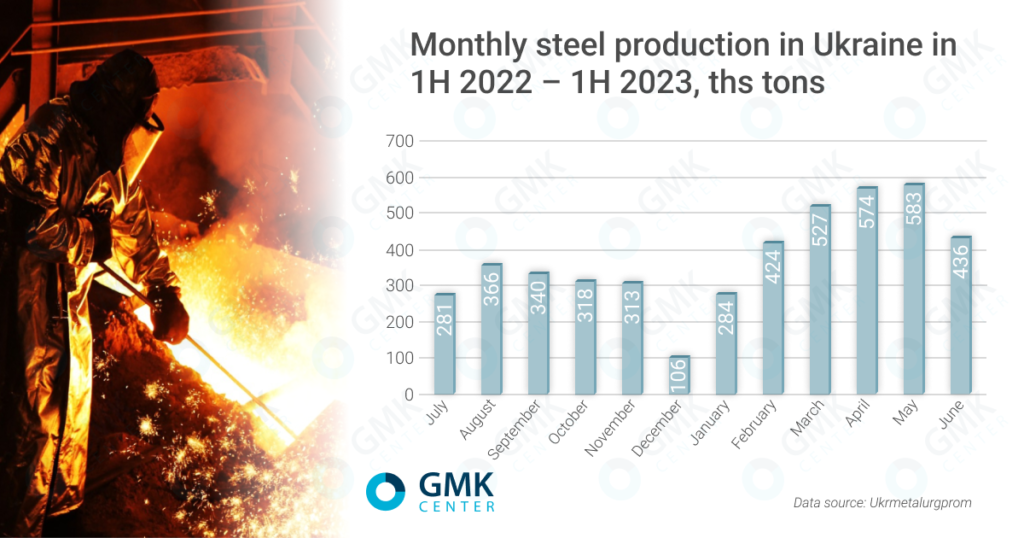
Posts Industry electricity 5592 15 April 2024
Due to the risks of new strikes on the energy infrastructure, no one can guarantee the stability of power supply
In late March and the first half of April, the Russian Federation launched missile strikes on about a dozen Ukrainian thermal power plants and thermal power stations, as well as two hydroelectric power plants. As a result of the shelling, substations, backbone networks of NEC Ukrenergo and networks of oblenergos were also damaged. Because of this, emergency blackouts began in the largest industrial regions of the country. Although the situation has stabilized since then, the situation remains precarious due to the threat of repeated shelling, which calls into question the plans of industrial enterprises and, in particular, steelmakers to increase production.
Emergency situation
As a result of rocket attacks on March 22 and 29, the Ukrainian energy system lost approximately 6 GW of capacity. New losses were added after the attack on April 11. Cumulatively, as a result of these attacks, Centrenergo lost all of its generating capacity, while DTEK lost more than 80%. The Energy Research Center estimates that the attacks cumulatively damaged or completely destroyed 35-40% of all generating capacities in the Ukrainian energy system.
Already after the first attack on the energy infrastructure, which took place on March 22, emergency power cuts began in nine Ukrainian regions. Initially, the restrictions affected Dnipropetrovsk, Donetsk, Zaporizhia, Kirovograd, Odessa, Poltava, Sumy, Kharkiv and Khmelnitsky regions. The emergency recovery works allowed to stabilize the Ukrainian system and restore power supply to subscribers.
So far, the problems of energy supply have been solved by generation at nuclear power plants and solar power plants, imports from Romania, Slovakia, Poland, Hungary, Moldova, as well as by limiting consumption through emergency shutdowns and setting consumption limits. The overall energy consumption situation is also supported by persistently warm weather.
On April 4-5, Ukrenergo began to additionally apply temporary measures to limit consumption in the evening (from 18:00 to 22:00) in Dnipropetrovsk, Zaporizhzhia, Kirovograd, Poltava and Sumy regions. From March 22 to April 12, permanent restrictions were in effect only in Kharkiv region and for industrial consumers in Kryvyi Rih Rig. All these measures significantly limit the prospects for increasing production at enterprises in the largest industrial regions.
Darkness is the enemy of production
Stabilization of electricity supplies allowed steel companies to continue fulfilling production tasks. Representatives of the industry interviewed by GMK Center say that the March disruptions did not affect the nature and performance of work. According to OP Ukrmetalurgprom, steelmaking in March increased by 14.9% to 611,000 tons.
«We did not have any serious problems. If anything, it was in the first hours after the shelling. In general, everything is normal,» GMK Center’s source in one of the major steel companies said.
However, the risks of repeated strikes and deterioration of the stability of power supply remain extremely high, especially after the shelling on April 11. The main consequence of power supply restrictions may be a decrease in production volumes. Capacity shutdown will be necessary to keep the equipment and the enterprise as a whole operational.
«Recently there have been more frequent cases of disconnection of PJSC AMKR equipment from electricity, which directly affects both the level of production of the main types of products and the operability of the main units», noted ArcelorMittal Kryvyi Rih.
Also, in conditions of unstable power supply, the enterprises of the industry may postpone their plans to increase production. In particular, ArcelorMittal Kryvyi Rih planned to increase capacity utilization from 25% to 50% of pre-war capacities for the nearest period – to load the mining department to the maximum, and to start the steel division with two blast furnaces from April. All the enterprises of the industry for the current year laid down production growth of 10-15%, but now it may be necessary to reduce production and adjust business plans.
In October-2022 – February-2023, Ukrainian steelmakers faced such a situation during the first wave of Russian shelling of energy infrastructure facilities and power supply disruptions. Then the industry held out for several months, but in December-2022 sharply reduced steelmaking by 66% m/m. The cumulative losses in the form of reduced production in that case were estimated at least 250,000 tons of steel.

The shaky situation with electricity supply to industrial consumers further worsens the prospects for the energy-intensive ferroalloy industry. Due to high electricity tariffs, falling prices for ferroalloys and constant threats of shelling, all plants in the industry have been idle since last fall. Until recently, the plants had no plans to resume production, and under the new circumstances, such a decision may be even more distant.
Countermeasures
Due to the specifics of technological processes, steel enterprises have limited opportunities to influence the situation. All technological processes are associated with electricity consumption. For example, it is impossible to safely stop the process of iron and steel smelting, especially when using electric arc furnaces, in case of an emergency shutdown. Therefore, the only operational solution in case of emergency power outages is to suspend production or individual technological processes.
The situation is a little better if there are energy consumption limits or firm deadlines for limiting power supply. In this case, enterprises can vary the level of production activity. ArcelorMittal Kryvyi Rih tried to partially adjust to work in the daytime (due to increased solar generation).
Mining companies are less dependent on energy supplies. Some operations – stripping, blasting, rock and waste removal – may not directly require power supply or may be carried out using diesel equipment. However, key technological processes such as ore processing and beneficiation depend on energy supply. However, even in the mining business, there are companies whose operations will not be affected by the restriction of energy supplies.
«The power outage in Dnipropetrovsk region will not affect the company’s current operations and production plans in any way. “Rudomain” is ready for such a situation since the last wave of blackouts, which occurred in late 2022 – early 2023. Each division is equipped with sufficiently powerful generators to fulfill the necessary production tasks,» Rudomain noted.
One of the options to ensure uninterrupted power supplies is direct import of electricity. However, when implementing this mechanism, there are capacity limitations and the requirement of the integrity of the energy system in the region. In addition, the price of European electricity is several times higher than that of Ukrainian electricity.
In the medium term, Ukrainian MMC enterprises can create their own generation. Some companies already have such experience. For example, Ferrexpo launched a 5 MW solar power plant back in 2021. Although its generation in 2022 amounted to only 1% of the total consumption, but the beginning has been made. In general, the creation of in-house generation is not a quick and capital-intensive issue, and it may not be an option for all iron and steel companies.
Energy prospects
As far as possible, the Ukrainian energy sector has been able to restore stable power supply. As of April 12, restrictions were applied only in Kharkiv Region and for industrial consumers of Kryvyi Rih.
However, in general, the prospects for stable power supply for industrial consumers do not look very bright. Massive attacks on CHPPs, HPPs and the entire power grids have jeopardized the stability of the Ukrainian energy system. The destruction of generating capacities of the Tripilska TPP during the missile attack on April 11 will have a negative impact on Ukraine’s ability to cover the growth of electricity consumption during peak evening hours. In turn, attacks on distribution systems also lead to interruptions in the supply of electricity to consumers.
The situation can be largely mitigated by imports. And although Ukrenergo says that it has enough equipment, repair crews, and special vehicles to promptly restore power supply, the situation may worsen at any moment due to a repeat of the missile and drone attacks. In addition, a significant shortage may arise as early as in May, when NPP power units go into scheduled maintenance.
There is simply no quick and effective solution to the problem of ensuring the stability of power supply under war conditions, especially taking into account the risks of new strikes on the energy infrastructure. Meanwhile, the physical protection elements of power plants and substations at best protect against drones and debris, not direct missile hits.
The only option to protect the energy system from missile attacks, apart from a complete «closing of the sky» by air defense systems (which is unlikely given the existing volumes of military aid from partners), is decentralization of generation. This implies dispersal of electricity generation throughout Ukraine through hundreds of small power plants with a capacity of 5 to 30 MW, development of alternative sources and energy storage systems. Implementation of such a program will require multi-billion dollar investments and several years of work.





